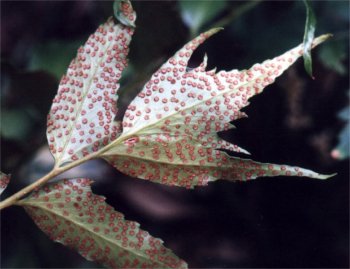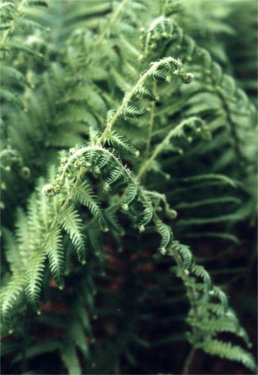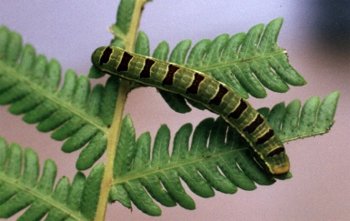Ferns
by Valerie (September 3, 2000)

Although most ferns fit the typical image of their group, i.e. living in lush, damp, cool, or shady surroundings, there are three popular ferns used in our area. The first of these is rather surprising, since it is a water plant. Four-leaf clover, or water fern (Marsilia quadrifolia), is a lovely floating plant that does well in one of our ponds. It is the largest of the Marsilia genus that I've seen around this area, and it is not native. However, there are couple of smaller species that grow in constantly moist areas, such as seeps and springs.
The leaves of this plant emerge from the water and usually grow a couple inches above it, but as they open, their weight pulls them back to the surface, where goldfish tend to nibble on them.
Holly ferns (Cyrtomium falcatum) are a popular shade loving, drought resistant landscape plant in this area. Their shiny, dark green foliage and exotic shape add interest to the usual ivy and liriope choices for under large live oak trees. Like other ferns, they reproduce by means of spores in small groups called sori, which can be seen in this view of the underside of one of the leaves.
By far the most common fern in Austin is the wood, or river, fern (Thelypteris kunthii). It does exceedingly well in hot, dry conditions, but grows larger in shade and if given supplemental water. In drier, or sunnier spots, it remains quite small. This fern spreads underground and is extremely easy to transplant. As the bed along the side of our front sidewalk got overcrowded, I simply pulled up the extra rhizomes and stuck them in the ground where we wanted more ferns. In only a year or two, the new areas were thick with ferns.
The wood ferns die back in the winter, but sprout very early in the spring. In order for the beds to look nice, it is necessary to cut out the old leaves, since they are brown and unsightly, but the new foliage lasts all season until it freezes. Even though almost nothing eats ferns, I found this well-camouflaged caterpillar munching away on them, and it is the only one I've ever seen. |


